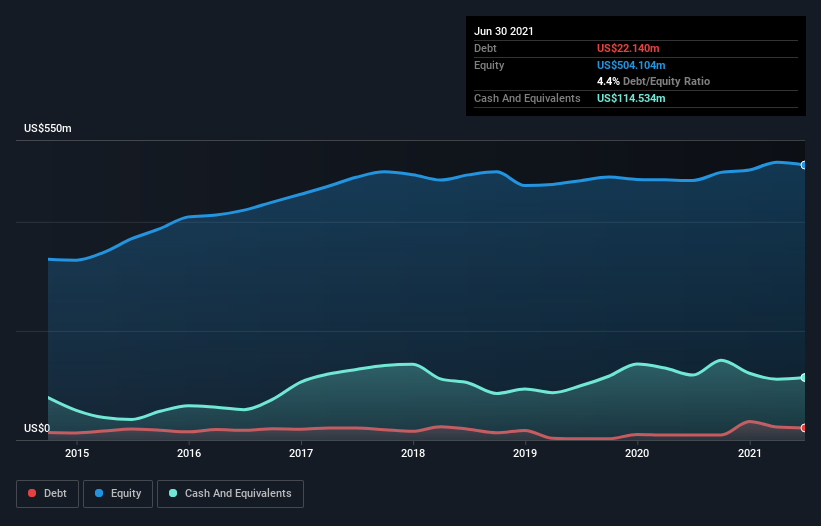Caesarstone (NASDAQ:CSTE) Has A Rock Solid Balance Sheet
Legendary fund manager Li Lu (who Charlie Munger backed) once said, 'The biggest investment risk is not the volatility of prices, but whether you will suffer a permanent loss of capital.' When we think about how risky a company is, we always like to look at its use of debt, since debt overload can lead to ruin. As with many other companies Caesarstone Ltd. (NASDAQ:CSTE) makes use of debt. But is this debt a concern to shareholders?
When Is Debt A Problem?
Debt is a tool to help businesses grow, but if a business is incapable of paying off its lenders, then it exists at their mercy. In the worst case scenario, a company can go bankrupt if it cannot pay its creditors. While that is not too common, we often do see indebted companies permanently diluting shareholders because lenders force them to raise capital at a distressed price. Of course, the upside of debt is that it often represents cheap capital, especially when it replaces dilution in a company with the ability to reinvest at high rates of return. When we think about a company's use of debt, we first look at cash and debt together.
Check out our latest analysis for Caesarstone
What Is Caesarstone's Net Debt?
The image below, which you can click on for greater detail, shows that at June 2021 Caesarstone had debt of US$22.1m, up from US$9.12m in one year. But on the other hand it also has US$114.5m in cash, leading to a US$92.4m net cash position.
A Look At Caesarstone's Liabilities
Zooming in on the latest balance sheet data, we can see that Caesarstone had liabilities of US$171.4m due within 12 months and liabilities of US$152.9m due beyond that. On the other hand, it had cash of US$114.5m and US$126.6m worth of receivables due within a year. So it has liabilities totalling US$83.3m more than its cash and near-term receivables, combined.
Given Caesarstone has a market capitalization of US$449.1m, it's hard to believe these liabilities pose much threat. However, we do think it is worth keeping an eye on its balance sheet strength, as it may change over time. Despite its noteworthy liabilities, Caesarstone boasts net cash, so it's fair to say it does not have a heavy debt load!
On top of that, Caesarstone grew its EBIT by 83% over the last twelve months, and that growth will make it easier to handle its debt. When analysing debt levels, the balance sheet is the obvious place to start. But ultimately the future profitability of the business will decide if Caesarstone can strengthen its balance sheet over time. So if you want to see what the professionals think, you might find this free report on analyst profit forecasts to be interesting.
But our final consideration is also important, because a company cannot pay debt with paper profits; it needs cold hard cash. Caesarstone may have net cash on the balance sheet, but it is still interesting to look at how well the business converts its earnings before interest and tax (EBIT) to free cash flow, because that will influence both its need for, and its capacity to manage debt. Over the last three years, Caesarstone actually produced more free cash flow than EBIT. That sort of strong cash conversion gets us as excited as the crowd when the beat drops at a Daft Punk concert.
Summing up
Although Caesarstone's balance sheet isn't particularly strong, due to the total liabilities, it is clearly positive to see that it has net cash of US$92.4m. The cherry on top was that in converted 108% of that EBIT to free cash flow, bringing in US$46m. So is Caesarstone's debt a risk? It doesn't seem so to us. Above most other metrics, we think its important to track how fast earnings per share is growing, if at all. If you've also come to that realization, you're in luck, because today you can view this interactive graph of Caesarstone's earnings per share history for free.
If you're interested in investing in businesses that can grow profits without the burden of debt, then check out this free list of growing businesses that have net cash on the balance sheet.
This article by Simply Wall St is general in nature. We provide commentary based on historical data and analyst forecasts only using an unbiased methodology and our articles are not intended to be financial advice. It does not constitute a recommendation to buy or sell any stock, and does not take account of your objectives, or your financial situation. We aim to bring you long-term focused analysis driven by fundamental data. Note that our analysis may not factor in the latest price-sensitive company announcements or qualitative material. Simply Wall St has no position in any stocks mentioned.
Have feedback on this article? Concerned about the content? Get in touch with us directly. Alternatively, email editorial-team (at) simplywallst.com.

 Yahoo Finance
Yahoo Finance 
